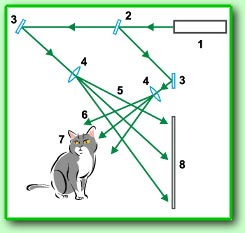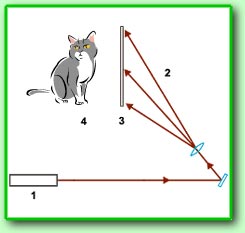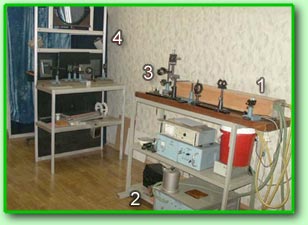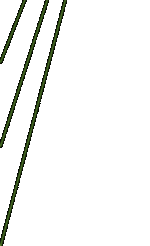|
13. Scheme of
pulse transparent hologram recording
The
great advantage of recording the holograms with
the help of pulse laser consists in absence of problems
connected with instability of fixing a photographic
plate and an object. You can simply hold both a
photographic plate and an object in your hands!
It's possible to photograph people and animals,
flowers and butterflies, soap bubbles and puffs
of smoke. In essence there remains only one insignificant
restriction on the object - its dimensions shouldn't
exceed the photographic plate sizes. So you can
imagine which freedom gains the holographists and
painters working with three-dimensional images.
But payment for such freedom is a significant complication
of equipment and technology. Use of pulse laser
for recording holograms leads to a principal change
both in optical lay-out of recording holograms and
in their chemico-photographic treatment. The process
of making a hologram by now includes two stages
- recording a transmission master hologram and manufacture
of a reflecting copy. Except for using complex and
expensive pulse device the plant for copying a hologram
on the basis of the He-Ne laser is also necessary
(some companies manufacture pulse setups, which
allow to record both transmission master-holograms
and reflecting copies, but prices of these setups
are very high).
 By recording a transmission
hologram both a reference and an object beams fall
on the photographic plate from one side (see fig.).
In essence it's one of the variants of the first
holographic layout developed by Leith and Upatnieks
immediately after invention of a laser. The laser
beam 1 is divided into two beams by a semi-transparent
mirror 2. The reference beam 5 is
directed to the filter 4 by the mirror 3
and directly illuminates the photographic plate
8. The signal beam 6 is also directed
by the mirror 3 passes through the spatial
filter 4 and illuminates the object 7.
For expansion of the signal beam opal glasses can
be used instead of the spatial filter. The photographic
plate registers the interference image created through
interference between the reference light beam and
the light reflected from the object. By recording a transmission
hologram both a reference and an object beams fall
on the photographic plate from one side (see fig.).
In essence it's one of the variants of the first
holographic layout developed by Leith and Upatnieks
immediately after invention of a laser. The laser
beam 1 is divided into two beams by a semi-transparent
mirror 2. The reference beam 5 is
directed to the filter 4 by the mirror 3
and directly illuminates the photographic plate
8. The signal beam 6 is also directed
by the mirror 3 passes through the spatial
filter 4 and illuminates the object 7.
For expansion of the signal beam opal glasses can
be used instead of the spatial filter. The photographic
plate registers the interference image created through
interference between the reference light beam and
the light reflected from the object.
 After photo-chemical treatment
of the photographic plate we obtain a transmisson
hologram. If you illuminate such a hologram by the
reference beam so looking through the hologram as
through a glass plate you can see a three-dimensional
image on the same place where the object was situated
(see fig). Colour of the image is determined by
the colour of laser radiation. And if by illumination
with the help of a laser the transmitting hologram
gives a faultless and sharp over the whole volume
image, in the ordinary white light it restores only
a diffuse achromatic image. For obtaining a high-quality
image in white light the transmission hologram should
be copied on the reflecting hologram. After photo-chemical treatment
of the photographic plate we obtain a transmisson
hologram. If you illuminate such a hologram by the
reference beam so looking through the hologram as
through a glass plate you can see a three-dimensional
image on the same place where the object was situated
(see fig). Colour of the image is determined by
the colour of laser radiation. And if by illumination
with the help of a laser the transmitting hologram
gives a faultless and sharp over the whole volume
image, in the ordinary white light it restores only
a diffuse achromatic image. For obtaining a high-quality
image in white light the transmission hologram should
be copied on the reflecting hologram.
 The pulse holographic setup
is shown on the photo. The pulse laser 1
with power supply units 2 and the layout
of beams separation 3 is mounted on a separate
support. The object is placed in the shooting cabin
4 - it's an important element of the setup.
For increase of expressiveness of the holographic
image the cabin should be equipped by various demountable
backgrounds and additional means of illumination
of objects - opaque glasses, mirrors, prisms, optical
fibres etc. --> The pulse holographic setup
is shown on the photo. The pulse laser 1
with power supply units 2 and the layout
of beams separation 3 is mounted on a separate
support. The object is placed in the shooting cabin
4 - it's an important element of the setup.
For increase of expressiveness of the holographic
image the cabin should be equipped by various demountable
backgrounds and additional means of illumination
of objects - opaque glasses, mirrors, prisms, optical
fibres etc. -->
|





